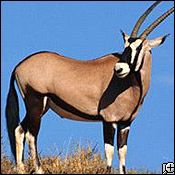Herds of ten to forty gemsbock are not uncommon and groups of up to a hundred have been recorded.
These animals are frequently found in association with other species of gazelles and sometimes zebras, foraging for grasses and leaves.
Advertisement
Gemsbock can go many days without water, but in the more arid parts of their range, they sometimes dig a trough in a dried-out river bed to reach the water table below and quench their thirst.
The males are often found alone and may be quite aggressive. When they fight, they lower their heads and fence, their long horns pointing straight out.
These "sword fights" are for display and rarely shed blood.
Advertisement
